Blackfin Tuna
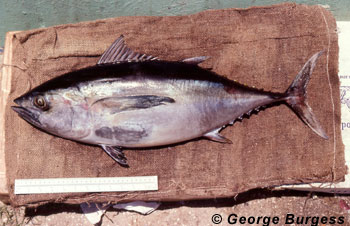
Thunnus atlanticus
These migratory tuna prefer the warm coastal waters of the Western Atlantic, where they form large schools with skipjack tuna and strain prey out of the water like smaller fish, squid, and shrimp. Torpedo-shaped and strong swimmers, they are dark on top, fading to silver and then white underneath, sometimes with iridescent patches on their sides. They have small bronze colored finlets running from their sturdy pectoral and anal fins towards their crescent caudal (tail) fin. Growing to around 39 inches long and 46 pounds, this is an important fish to both commercial and recreational fisheries.
Order – Perciformes
Family – Scombridae
Genus – Thunnus
Species – atlanticus
Common Names
Blackfin tuna (English), albacore (English), deep-bodied tunny (English), albacora (Portuguese), albacorinha (Portuguese), atlanticheskyj tunets (Russian), atum-barbatana-negra (Portuguese), atum-preto (Portuguese), atun (Spanish), atun aleta negra (Spanish), atun Atlantico (Spanish), atun des aleta negras (Spanish), bonite (French), bonite noire (French), chernij tunets Russian), falsa albacora (Spanish), giromon (French), mini maguro (Japanese), monte maguro (Japanese), petit thon (French), taiseiyomaguro (Japanese), thon noir (French), thon nuit (French), and ton noir (Creole).
Importance to Humans
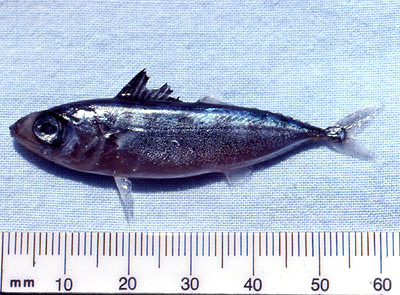
This tuna is important to the commercial and recreational fishing industry. There is a major fishery off the coast of Cuba and throughout the Caribbean where it is common. Around south Florida and the Bahamas, the sport fishery is also important due to the proximity to deep water. This tuna is highly regarded for its fighting ability. The flesh is of excellent food quality and is marketed fresh, dried and salted, canned, and frozen. Off Cuba it is caught with poles and live bait, while elsewhere it is caught by trolling and drift fishing.
Conservation
> Check the status of the blackfin tuna at the IUCN website.
The IUCN is a global union of states, governmental agencies, and non-governmental organizations in a partnership that assesses the conservation status of species.
Geographical Distribution
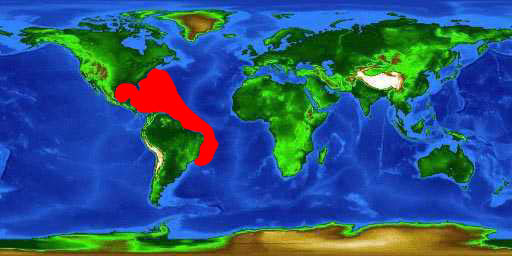
The blackfin tuna is one of the few tuna with a limited range. It occurs only in the western Atlantic Ocean from Massachusetts (US) south to Rio de Janeiro (Brazil), including the Gulf of Mexico and Caribbean Sea. It is abundant in tropical regions, however in the northern Gulf of Mexico the yellowfin tuna (Thunnus albacares) is more common than the blackfin tuna. The blackfin tuna is a highly migratory species, moving into more temperate waters during the summer months.
Habitat
Occurring in oceanic waters in close proximity to the coastline, the blackfin tuna prefers clean water and warm temperatures, usually seaward from the continental shelf. It is a strongly schooling, migratory fish, often forming large mixed schools with skipjack tuna (Katsuwonus pelamis). During the summer months, the blackfin tuna migrates to temperate waters remaining above 70°F (21°C). It is most abundant off the Florida coast during autumn, winter, and spring.
Biology
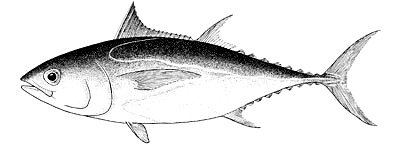
Distinctive Features
As one of the smaller tuna species, the blackfin tuna has a robust, fusiform body, with small, compact scales completely covering the body. The mouth is oblique and the maxillary jaw terminates prior to the vertical from the center of the large eye. The corselet, a band of larger scales forming a circle around the body behind the head, is small and inconspicuous. Pectoral fins are moderately long, reaching below the origin of the second dorsal fin. There are separate finlets located behind the anal and dorsal fins. The lunate caudal fin has short keels at its base. Blackfin tuna swim primarily through movements of the caudal fin and body. The second spine on the dorsal fin is the highest with the first spine almost as high. The anal fin is similar in appearance to the soft, low dorsal fin. Anteriorly, the lateral line has a distinctive dip, descending posteriorly to the pectoral fin origin, then ascending to a point below the 3rd or 4th dorsal spine, then continuing straight to the caudal keel.
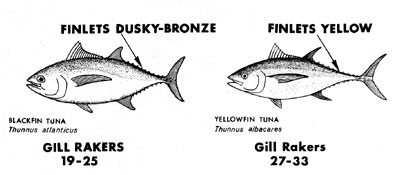
The number of gill rakers, small, flesh-colored knobby structures located on the inside of each gill, can be used to distinguish young blackfin tuna from other tuna species. The blackfin tuna has only about 20-23 on the first arch, fewest of all the Atlantic tuna species. Most other species have approximately 30 or more gill rakers. The ventral surface of the liver, visible as a pink-red organ in the chest region when opening the body cavity, can also be used to positively identify the blackfin tuna. Other tuna species have striations on the ventral surface of the liver while on the blackfin tuna, this surface is smooth. A small swim bladder is present.
Coloration
The blackfin tuna has a bluish-black back with gray to silver sides and a white belly. A broad, brown stripe is located along the upper portion of the eye. There is a prominent yellow to golden-colored lateral band present on the sides, usually fading upon death. Small iridescent areas located on the sides of the abdomen are silvery. This area is sometimes marked with vertical rows of pale dots along with slightly elongate spots between these rows. The dorsal finlets are dusky with bronzy reflections and white edges while the ventral finlets are usually gray. The absence of yellow on these finlets distinguishes the blackfin tuna from all other tunas. However, the dorsal finlets sometimes fade to yellow upon death.
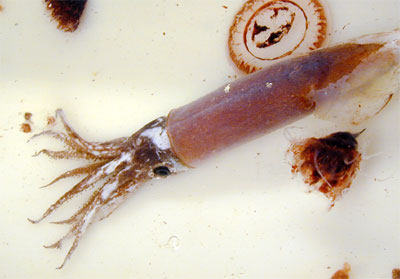
Size, Age, and Growth
Blackfin tuna reach a maximum size of 39 inches (100 cm) in length and 46 pounds (21 kg) in weight. They are most frequently taken at an average size of approximately 19.75 inches (50 cm), corresponding to a weight of about 7 pounds (3.2 kg). Maturity is reached at lengths of 16-20 inches (40-50 cm). The blackfin tuna may live past 5 years of age. Growth rates have been reported at .4-.6 inches (1-1.5 cm) per month. The all-tackle world record for the blackfin tuna is 45 pounds 8 ounces (20.6 kg) caught off the coast of Florida.
Food Habits
Various fish, squid, amphipods, shrimp, crabs, and stomatopods constitute the diet of the blackfin tuna. It often feeds in surface waters where they form large mixed schools with skipjack tuna (Katsuwonus pelamis). It directly competes with the skipjack tuna for prey, and is occasionally even preyed upon by it. Blackfin tuna feed by straining prey from the water as well as chasing and capturing prey which is then engulfed.
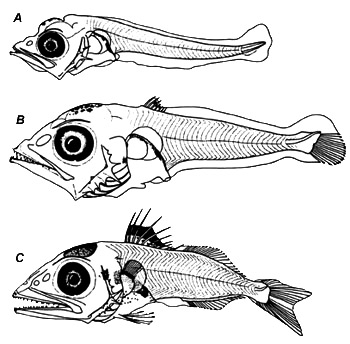
Reproduction
Spawning occurs in April through November off the Florida coast, and June to September in the Gulf of Mexico, well offshore in the blue oceanic waters of the Florida current as well as in the coastal waters of northern Brazil. The fish release sperm and eggs into the water column where fertizilation occurs. The buoyant eggs produce pelagic larvae, little else is known about the eggs. These larvae are found in the open ocean at depths ranging from the surface down to 164 feet (50m). The vertebral column is developed by a length of 11.0 mm, while all fin rays develop by lengths of approximately 20mm.
At a length of 28mm, the young blackfin tuna has some pigmentation. The first dorsal fin is pigmented, but not entirely black. Dark pigmentation also exists from the top of the head through to the brain region. The body is heavily pigmented dorsally, with a concentration of pigment concentrated along the lateral line as well as areas along the dorsal and lateral areas, resulting in a faint pattern of six vertical bars.
Predators
Dolphinfish (Coryphaena hippurus), blue marlin (Makaira nigricans), skipjack tuna (Katsuwonus pelamis) and various sea birds all prey on the blackfin tuna during its life cycle. In fact, it is one of the most common items in the diet of the blue marlin. Cannibalism also occurs in this tuna.
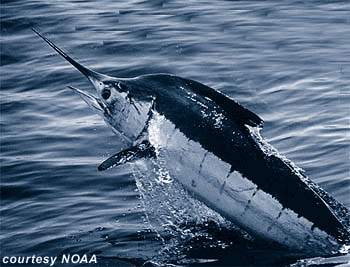
Parasites
The blackfin tuna is a host to at least 9 species of parasites, with none being host-specific. Parasites include digenea (flukes), monogenea (gillworms), cestoda (tapeworms), nematoda (roundworms), copepods, and the cookiecutter shark (Isistius brasiliensis). Parasitic copepods associated with this tuna include Caligus coryphaena, C. productus, Euryphorus brachypterus, and Pseudocycnus appendiculatus.
Taxonomy
Lesson first described the blackfin tuna as Thunnus atlanticus in 1831. The genus name Thunnus is derived from the Greek “thynnos” meaning tunna. Synonyms referring to this fish include Thynnus balteatus Cuvier 1832, Thunnus balteatus South 1845, Thunnus coretta South 1845, Orcynus balteatus Cuvier 1832, Parathunnus rosengarteni Fowler 1934, Parathunnus ambiguus Mowbray 1935, and Parathunnus atlanticus Beebe and Hollister 1935.
The family Scombridae are primarily swift predators of the open seas and are among the most important of commercial and sport fishes.
Prepared by: Susie Gardieff